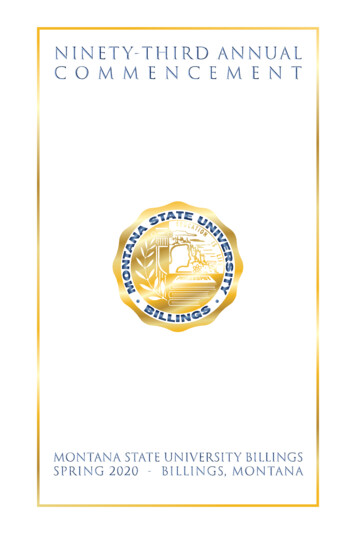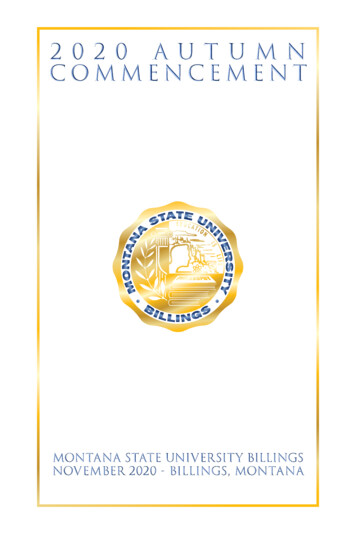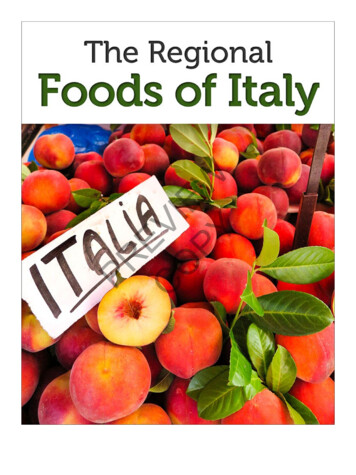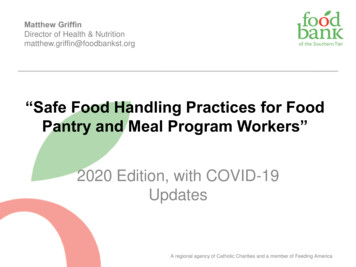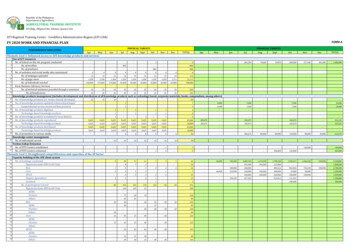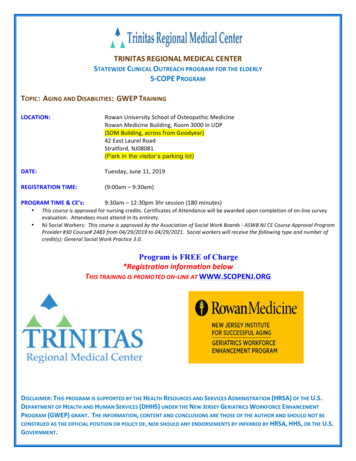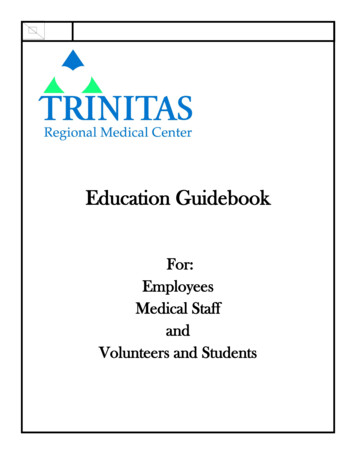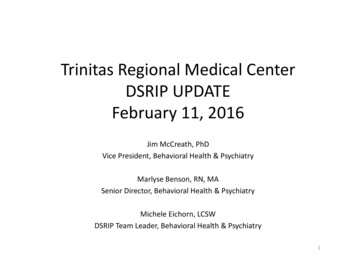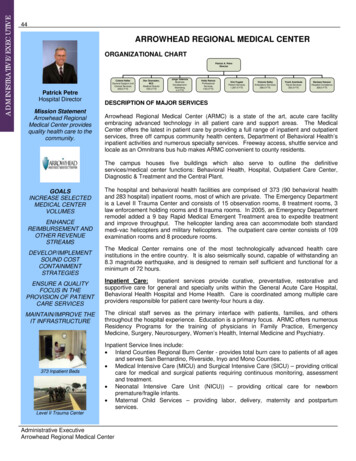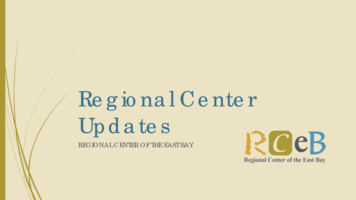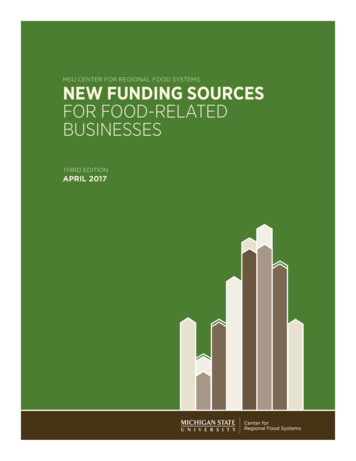
Transcription
MSU CENTER FOR REGIONAL FOOD SYSTEMSNEW FUNDING SOURCESFOR FOOD-RELATEDBUSINESSESTHIRD EDITIONAPRIL 2017
NEW FUNDING SOURCESFOR FOOD-RELATED BUSINESSESTABLE OF CONTENTSSECTION 1: INTRODUCTIONBefore You Begin, Do You Have a Business Plan? . . . . . .65What Type of Financing Do You Need? . . . . . . . . . . . . 7SECTION 2: CROWDFUNDING8Barnraiser . . . . . . . . . . . . . . . . . . . . . . . . . . . . . 8Foodstart . . . . . . . . . . . . . . . . . . . . . . . . . . . . . 14CircleUp . . . . . . . . . . . . . . . . . . . . . . . . . . . . . . 9FundRazr . . . . . . . . . . . . . . . . . . . . . . . . . . . . . 15Credibles . . . . . . . . . . . . . . . . . . . . . . . . . . . . . 10Indiegogo . . . . . . . . . . . . . . . . . . . . . . . . . . . . . 15Crowdfunder . . . . . . . . . . . . . . . . . . . . . . . . . . . 11Kickstarter . . . . . . . . . . . . . . . . . . . . . . . . . . . . 16CrowdMole . . . . . . . . . . . . . . . . . . . . . . . . . . . . 11Lendio . . . . . . . . . . . . . . . . . . . . . . . . . . . . . . . 16EquityEats . . . . . . . . . . . . . . . . . . . . . . . . . . . . 12Localstake . . . . . . . . . . . . . . . . . . . . . . . . . . . . 17Foodie Crowd Funding . . . . . . . . . . . . . . . . . . . . . 13Patronicity . . . . . . . . . . . . . . . . . . . . . . . . . . . . 18SECTION 3: START-UP ACCELERATOR RESOURCESAccelFoods . . . . . . . . . . . . . . . . . . . . . . . . . . . . 1919food-x . . . . . . . . . . . . . . . . . . . . . . . . . . . . . . 20Food Hatch . . . . . . . . . . . . . . . . . . . . . . . . . . . 20SECTION 4: MISCELLANEOUS RESOURCESBen and Jerry’s Foundation, Grassroots Organizingfor Social Change Program . . . . . . . . . . . . . . . . . . 21Farm Aid Grant Program . . . . . . . . . . . . . . . . . . . 22Greenstone Farm Credit Services . . . . . . . . . . . . . . 23Kiva . . . . . . . . . . . . . . . . . . . . . . . . . . . . . . . . 2421Northwest Michigan Farm and Food 20/20 Fund . . . . . 30Opportunity Resource Fund (OppFund) . . . . . . . . . . 31Patagonia . . . . . . . . . . . . . . . . . . . . . . . . . . . . 32Prosper . . . . . . . . . . . . . . . . . . . . . . . . . . . . . . 33Lending Club . . . . . . . . . . . . . . . . . . . . . . . . . . 25Robert Wood Johnson Foundation,Culture of Health Prize . . . . . . . . . . . . . . . . . . . . . 34Metro Community Development (Flint Area) . . . . . . . 26RSF Social Finance . . . . . . . . . . . . . . . . . . . . . . . 35Michigan Good Food Fund . . . . . . . . . . . . . . . . . . 27SPARK (Ann Arbor) . . . . . . . . . . . . . . . . . . . . . . 36Natural Capital Investment Fund . . . . . . . . . . . . . . . 28Whole Foods Market, Local Producer Loan Program . . . 37Northern Initiatives . . . . . . . . . . . . . . . . . . . . . . . 29Women’s Foundation (Michigan) . . . . . . . . . . . . . . 38MSU CENTER FOR REGIONAL FOOD SYSTEMS // NEW FUNDING SOURCES FOR FOOD-RELATED BUSINESSES2
TABLE OF CONTENTS (continued)SECTION 5: ADDITIONAL SOURCES OF FUNDING INFORMATION39Michigan Small Business Development Cetner, Business Accelerator Fund . . . . . . . . . . . . . . . . . . . . . . . . . . . . 40State of Michigan, Department of Agriculture and Rural DevelopmentRural Development Fund Grants . . . . . . . . . . . . . . . . . . . . . . . . . . . . . . . . . . . . . . . . . . . . . . . . . . . .41Specialty Crop Block Grant Program . . . . . . . . . . . . . . . . . . . . . . . . . . . . . . . . . . . . . . . . . . . . . . . . . 42Value-Added Grant Program . . . . . . . . . . . . . . . . . . . . . . . . . . . . . . . . . . . . . . . . . . . . . . . . . . . . . 43USDA, Agricultural Marketing ServiceFarmers Market Promotion Program (FMPP) . . . . . . . . . . . . . . . . . . . . . . . . . . . . . . . . . . . . . . . . . . . . 44Local Food Promotion Program (LFPP) . . . . . . . . . . . . . . . . . . . . . . . . . . . . . . . . . . . . . . . . . . . . . . . 45USDA, Farm Service AgencyFarm Storage Facility Loan Program . . . . . . . . . . . . . . . . . . . . . . . . . . . . . . . . . . . . . . . . . . . . . . . . . 46USDA, Food and Nutrition ServiceFarm to School Grant Program . . . . . . . . . . . . . . . . . . . . . . . . . . . . . . . . . . . . . . . . . . . . . . . . . . . . 47USDA, National Institute of Food and AgricultureAgriculture and Food Research Initiative (AFRI): Agricultrual Economics and Rural Communities . . . . . . . . . . . . 48Agriculture and Food Research Initiative (AFRI): Improved Sustainable Food Systems . . . . . . . . . . . . . . . . . . . 49Beginning Farmer and Rancher Development . . . . . . . . . . . . . . . . . . . . . . . . . . . . . . . . . . . . . . . . . . . 50Community Food Projects Competitive Grants Program (CFPCGP) . . . . . . . . . . . . . . . . . . . . . . . . . . . . . . . 51Small Business Innovation Research (SBIR) . . . . . . . . . . . . . . . . . . . . . . . . . . . . . . . . . . . . . . . . . . . . . 52Sustainable Agriculture Research and Education (SARE) . . . . . . . . . . . . . . . . . . . . . . . . . . . . . . . . . . . . 53USDA, Rural DevelopmentBusiness and Industry Guaranteed Loan Progam (B&I) . . . . . . . . . . . . . . . . . . . . . . . . . . . . . . . . . . . . . . 54Community Facilities Grant and Loan Program . . . . . . . . . . . . . . . . . . . . . . . . . . . . . . . . . . . . . . . . . . . 55Rural Business Development Grant (RBDG) . . . . . . . . . . . . . . . . . . . . . . . . . . . . . . . . . . . . . . . . . . . . 56Rural Cooperative Development Grant (RCDG) . . . . . . . . . . . . . . . . . . . . . . . . . . . . . . . . . . . . . . . . . . 57Rural Economic Development Loan and Grant (REDLG) . . . . . . . . . . . . . . . . . . . . . . . . . . . . . . . . . . . . . 58Rural Energy for America Program: Renewable Energy System andEnergy Efficiency Improvement Guaranteed Loan and Grant Program . . . . . . . . . . . . . . . . . . . . . . . . . . . . 59Socially Disadvantaged Groups Grant (SDGG) . . . . . . . . . . . . . . . . . . . . . . . . . . . . . . . . . . . . . . . . . . . 60Value-Added Producer Grants (VAPG) . . . . . . . . . . . . . . . . . . . . . . . . . . . . . . . . . . . . . . . . . . . . . . . 60MSU CENTER FOR REGIONAL FOOD SYSTEMS // NEW FUNDING SOURCES FOR FOOD-RELATED BUSINESSES3
AuthorsCorresponding AuthorsAnel Guel,Graduate Student,Department of Community Sustainability,MIchigan State University(1st edition)Rich Pirog,Director,Center for Regional Food Systems,MIchigan State University(all editions)Rich Pirog,Director,Center for Regional Food Systems,MIchigan State University(all editions)Nick McCann,Specialist,Center for Regional Foods Systems,MIchigan State University(3rd edition)Rachel Kelly,Research Assistant,Center for Regional Food Systems,MIchigan State University(3rd edition)Nick McCann,Specialist,Center for Regional Foods Systems,MIchigan State University(3rd edition)Taylor Wimberg,Graduate Student,Department of Community Sustainability,MIchigan State University(2nd edition)Emily Kim,Undergraduate Student,Department of Community Sustainability,MIchigan State University(1st edition)Abby Harper,Specialist,Center for Regional Food SystemsMIchigan State University(1st edition)AcknowledgementsThe authors wish to thank Susan Cocciarelli andKathryn Colasanti with the Michigan State University(MSU) Center for Regional Food Systems (CRFS)for their review of the 1st edition of this document.Marty Gerencer of Morse Marketing Connections, LLCalso provided comments on specific sections of the1st edition, and Kathleen Reed, MSU Department ofCommunity Sustainability graduate student helpedwith the 2nd edition. We also wish to thank AndreaSexton, and Liz Gensler at CRFS, Kelsey Grimshaw atCRFS for her suggestions with layout and design onthe 2nd edition, Amy Bond-Nelson Moore of BondCreative for layout and design of this 3rd edtion,and Robin Miner-Swartz for copy editing of the 3rdedition. Support for this work comes from the W.K.Kellogg Foundation and the Kresge Foundation.Photo CreditsPage 5: Farm with rainbow near MSU Student OrganicFarm—MSU Center for Regional Food SystemsPage 7: A woman packaging bags at Kansas City CSADistribution—MSU Center for Regional Food SystemsSuggested CitationGuel, A., Pirog, R., Kelly, R., McCann, N., Wimberg,T., Kim, E. & Harper, A. (2017). Funding sourcesfor food-related businesses: Third edition. EastLansing, MI: MSU Center for Regional FoodSystems. Retrieved from foodsystems.msu.edu/resources/food business funding sourcesMSU CENTER FOR REGIONAL FOOD SYSTEMS // NEW FUNDING SOURCES FOR FOOD-RELATED BUSINESSES4
NEW FUNDING SOURCESFOR FOOD-RELATEDBUSINESSESSECTION 1: INTRODUCTIONPurpose of This DirectoryThis directory provides an overview of various sourcesof financing that may be available to food hubsand other food-related businesses. This directoryis a partial listing of what may be available acrossthe United States; some examples may not be agood match with your particular circumstances.The format for this directory was initially informedby a listing of funding resources for food-relatedbusinesses found on the Food Tech Connectwebsite, a media and research company buildinga network for food innovators and entrepreneurs(foodtechconnect.com). Many of the funding sourceslisted in this directory are available for local foodrelated businesses across the United States, butseveral additional funding websites are specificallyfor Michigan. All the information for each fundingentity has been researched through its own website.How the Directory WorksThe directory is divided into several category sources:crowd funding, accelerator, miscellaneous (non-Federal),and additional Federal resources. Each entity listedunder these four categories will have the title of anentity, a URL of its website, a description of how itworks, funding focus, funding limit, qualifications,and the entity’s financial geographic area.MSU CENTER FOR REGIONAL FOOD SYSTEMS // NEW FUNDING SOURCES FOR FOOD-RELATED BUSINESSES5
BEFORE YOU BEGIN, DO YOU HAVE A BUSINESS PLAN?At any stage of your business’s growth anddevelopment, an essential component of continuingsuccess is having an updated three- to five-yearplan that outlines how a company will grow itsbusiness and generate revenue. A good plan willoutline a business’s current state, resources, andabilities as well as a vision of where, when and howthe business is to grow. The business plan servesas a guiding document, allowing all employeesand shareholders to have a unified vision of thebusiness goals, a trajectory for goal achievements,and a framework for assessment and evaluation.Having a well-thought-out business plan is especiallyimportant when seeking new lenders and investors.A plan should show the company’s long-term abilityto generate profit in order to meet debt obligationsand become self-sufficient. Potential investors,whether large or small, will want reassurance thatyour business has a plan for financial stabilityin the future. It will also help you better assesswhat type and size of funding is necessary.While this directory is not intended to serve asa business-planning guide, below please findseveral resources for creating a business plan: B uilding Successful Food Hubs:A Business Planning Guide for Aggregating andProcessing Local Food in 1/IllinoisFoodHubGuide-final.pdf M innesota Department of Agriculture,Starting a Food Business in Minnesotamda.state.mn.us/ y governmental resources provide accessto business planning guides and templates: T he United States Small Business Administrationsba.gov/writing-business-plan M 00.html M issouri Business Development g-business-plan/In addition, the Michigan Small BusinessDevelopment Center offers workshops aroundthe state regarding business planning: M ichigan Small Business Development Centersbdcmichigan.org/get-started/MSU CENTER FOR REGIONAL FOOD SYSTEMS // NEW FUNDING SOURCES FOR FOOD-RELATED BUSINESSES6
WHAT TYPE OF FINANCINGDO YOU NEED?New Hampshire Community Loan Fund designedCapital Compass, an online educational tool tohelp food businesses understand the factors thataffect the type of capital owners may consider.The tool is not designed to make decisions for thebusiness or a financier. Please check out the linkbelow to see what type of capital fund may bemost appropriate to consider for your business.Tutorial and directions are available in the link.communityloanfund.org/capital-compassUseful Definitions for Capital Compass:Debt: Traditional method of a lender offeringa certain dollar value of credit (loans)Royalty: Growth financing structuredas a revenue-sharing agreementEquity: Selling shares of your companyMSU CENTER FOR REGIONAL FOOD SYSTEMS // NEW FUNDING SOURCES FOR FOOD-RELATED BUSINESSES7
SECTION 2: CROWDFUNDINGCrowdfunding is the practice of funding a project or venture by raising small amounts of money from a largenumber of people, typically via the internet.1 Crowdfunding has the added benefit of reaching a large pool ofinvestors who typically morally support a business’s agenda. The platform expands accessibility to investorswith varying levels of financial resources, as it allows funders to make both large and small contributions. Inaddition, it increases the support base of parties with a vested interest in the success of your business.There are several models of crowdfunding: donation, debt, equity, and reward-based. Donation-basedmodels depend on a shared belief in the cause by investors. Debt-based models promise a return ofinvestment to funders. Equity crowdfunding guarantees a share of the business for investors. Manybusiness start-ups employ reward crowdfunding as well, which offers investors services or goods fromtheir business. Most crowdfunding resources are best suited for small to medium-sized investments.Crowdfunding is a fundraising platform that is changing rapidly, so it is recommended that those interestedin using it to develop or grow their business do their own research first to make sure they have themost up-to-date information, particularly pertaining to terms of use, laws, and regulations. For furtherinformation and additional resources on crowdfunding, the Michigan Community Resources websitehas multiple guides on how entrepreneurs can use crowdfunding to start or grow their business.Visit lopment-entrepreneurship/1 Crowdfunding. (2014). In Oxford Dictionaries online. Retrieved from oxforddictionaries.com/us/definition/american english/crowdfundingBarnraiserbarnraiser.us/How It WorksFunding LimitBarnraiser is a social and funding community thatallows its members to influence and scale thefood movement by connecting to innovators ofsustainable food and farming, celebrating theirstories, and collectively backing projects thatshape how we farm and eat, locally and globally.Set by project creator but mustbe higher than 2,000Funding Focuses OnFarms; Food Hubs; Artisan, Local, Farmto-Table, and Healthy Foods; Food andFarming Education; Food MediaQualificationsNot specified. Anyone who has a passion forthe food movement, a U.S. bank account andcredit card, is over 18 and is a U.S. citizenFinancing Geographic AreaMostly United States (internationalunder certain conditions)MSU CENTER FOR REGIONAL FOOD SYSTEMS // NEW FUNDING SOURCES FOR FOOD-RELATED BUSINESSES8
CircleUpcircleup.com/How It WorksCircleUp is a crowdfunding platform connecting accredited investorswith innovative consumer and retail companies.Start-upCompanyCircleUpInvestorStart-up CompanyListed underCircleUp websiteInterestedinvestors fundFunding Focuses OnQualificationsBranded, tangible consumer products andretail companies; typically, but not limitedto, food and health related products.Must have at least 500,000/year revenue;CircleUp Seed Program accepts companieswith less than 500,000 revenueFunding LimitFinancing Geographic Area 500,000– 4.5 million (This range is basedon previously funded companies)United StatesMSU CENTER FOR REGIONAL FOOD SYSTEMS // NEW FUNDING SOURCES FOR FOOD-RELATED BUSINESSES9
Crediblescredibles.org/How It WorksBusinesses receive crowdfunding in exchange for store credits to their funders (one credit 1).SeedGrowHarvestPre-pay the businessnow and receiveCredibles—edible credits.The business uses yourprepayment to ramp upand grow its operations.Use your Credibles aspayment for futurepurchases as gifts.Funding Focuses OnQualificationsSmall, sustainable food-related businesses.Not specifiedFunding LimitFinancing Geographic AreaBusiness campaign average: 2,500– 50,000. Upper funding limit: 422,500.United StatesMSU CENTER FOR REGIONAL FOOD SYSTEMS // NEW FUNDING SOURCES FOR FOOD-RELATED BUSINESSES10
Crowdfundercrowdfunder.comHow It WorksQualificationsCrowdfunder is an equity crowdfunding platformthat allows businesses to fundraise online fromaccredited investors and venture capitalists.Crowdfunder is designed for early-stage startups and more mature businesses rather thaninception (beginning) stage companies.Must be an early start-up or mature business.Launching your campaign requires completion ofdocumentation including term sheet, executivesummary, and investor pitch deck. Gettingstarted with Crowdfunder is free, but there is aone-time fee for advertising your project to theCrowdfunding investor network. Various fundraisingpackages are available, and services vary bypackage. For example, the self-starter packagestarts at 499/month and includes services suchas analytics, investor browsing and support.Funding Focuses OnA variety of categories including smallbusinesses. Crowdfunder is not designedfor nonprofit companies at this timeFunding LimitFinancing Geographic AreaUnited States and globalNot specifiedCrowdMolecrowdmole.comHow It WorksQualificationsCrowdmole is a crowdfunding platform that helps buildonline, social communities that empower entrepreneursand small businesses. It only allows 20 live projects at atime. The concept of CrowdMole is to help businessesand entrepeneurs grow and succeed online.Must align with CrowdMole’s social good core valuesFinancing Geographic AreaUnited States and international under certain conditionsFunding Focuses OnEntrepreneurs and small businessesFunding
Ben and Jerry’s Foundation, Grassroots Organizing for Social Change Program 21 Farm Aid Grant Program 22 Greenstone Farm Credit Services 23 Kiva 24 . Business Accelerator Fund 40 State of Mich

